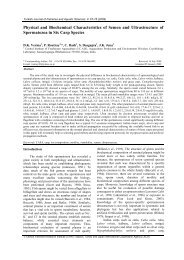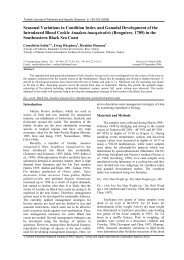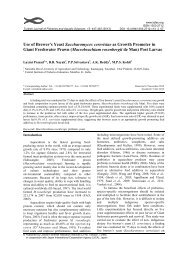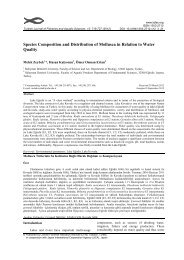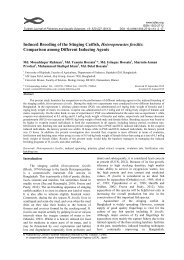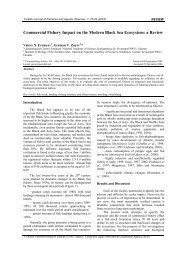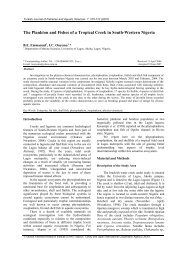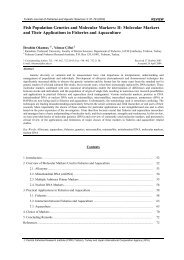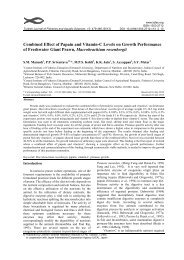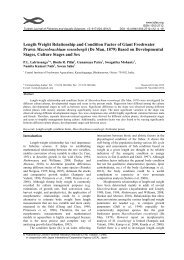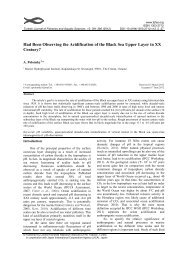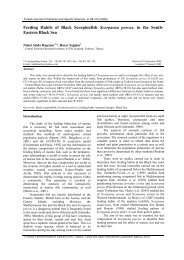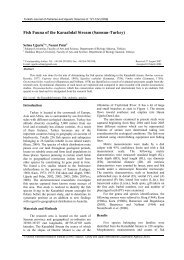Effects of Sodium Bicarbonate on Anaesthesia of Common Carp ...
Effects of Sodium Bicarbonate on Anaesthesia of Common Carp ...
Effects of Sodium Bicarbonate on Anaesthesia of Common Carp ...
You also want an ePaper? Increase the reach of your titles
YUMPU automatically turns print PDFs into web optimized ePapers that Google loves.
30 T. Altun et al. / Turk. J. Fish. Aquat. Sci. 9: 29-31 (2009)<br />
and 0 (c<strong>on</strong>trol), 400, 600, 1000, 1400, 2000 mg L -1 for<br />
7.7 pH) was added into each aquarium and water was<br />
mixed. The c<strong>on</strong>centrati<strong>on</strong>s were established by taking<br />
into c<strong>on</strong>siderati<strong>on</strong> <str<strong>on</strong>g>of</str<strong>on</strong>g> the results obtained from<br />
previous studies (Booke et al., 1978; Prince et al.,<br />
1995). Because NaHCO 3 alters pH, pH level <str<strong>on</strong>g>of</str<strong>on</strong>g> the<br />
water in each aquarium was measured, when fish was<br />
stocked. Measurements <str<strong>on</strong>g>of</str<strong>on</strong>g> pH and temperature <str<strong>on</strong>g>of</str<strong>on</strong>g> the<br />
water was carried out by pH meter (Toledo mark).<br />
After adding the anaesthetic agent, five fish was<br />
stocked into the each aquarium. When fish reached<br />
anaesthesia, inducti<strong>on</strong> time, anaesthesia stage,<br />
opercular rate and mortality <str<strong>on</strong>g>of</str<strong>on</strong>g> the fish were noted. It<br />
is generally accepted that there are five stages <str<strong>on</strong>g>of</str<strong>on</strong>g><br />
anaesthesia in fish (Coyle et al., 2004): however, in<br />
aquaculture applicati<strong>on</strong>s, stages were informed in<br />
different number and feature in previous studies. In<br />
this study, fish was observed for four different<br />
anaesthesia stages shown below and modified from<br />
anaesthesia stages identified by Abbas et al. (2006):<br />
1. Tranquility period (slow swimming and slight<br />
increase in opercular rate),<br />
2. Excitati<strong>on</strong> period (unrest voluntary swimming,<br />
still possible increase in opercular rate high<br />
reacti<strong>on</strong> to external stimuli),<br />
3. Light anaesthesia level (turning to <strong>on</strong>e side, still<br />
reacti<strong>on</strong> to external stimuli, high opercular rate<br />
loss <str<strong>on</strong>g>of</str<strong>on</strong>g> co-ordinati<strong>on</strong> excrement discharge)<br />
4. Deep anaesthesia (lying <strong>on</strong> <strong>on</strong>e side without<br />
movement, opercular movement very high (up to<br />
200 min -1 ) in some <str<strong>on</strong>g>of</str<strong>on</strong>g> the fish and very low (9-<br />
17 min L -1 ) in others increase in excrement<br />
discharge high reacti<strong>on</strong> to external stimuli in fish<br />
with a high opercular rate, and no reacti<strong>on</strong>s to<br />
external stimuli in those with a slow opercular<br />
rate).<br />
After the anaesthesia, fish was removed from<br />
anaesthetic added water and transferred to clean water<br />
aquarium. Recovery time was recorded and fish was<br />
maintained there for 48h in order to observe possible<br />
mortality.<br />
Results<br />
Anaesthetic effects <str<strong>on</strong>g>of</str<strong>on</strong>g> NaHCO 3 in different<br />
c<strong>on</strong>centrati<strong>on</strong>s and pH values at 23°C <strong>on</strong> comm<strong>on</strong><br />
carp were shown in Table 1.<br />
After stocking into the treatment aquaria, fish<br />
began to swim towards to aquarium walls and became<br />
hyperactive in first <strong>on</strong>e or two minutes in each group.<br />
Then, fish gathered in together and began to enter the<br />
anaesthesia. An increase in the c<strong>on</strong>centrati<strong>on</strong> <str<strong>on</strong>g>of</str<strong>on</strong>g><br />
NaHCO 3 increased pH level <str<strong>on</strong>g>of</str<strong>on</strong>g> the water, slightly<br />
(Table 1).<br />
In pH 6.5, fish reached from 1 to 3 <str<strong>on</strong>g>of</str<strong>on</strong>g> the<br />
anaesthesia stage; however, <strong>on</strong>ly half <str<strong>on</strong>g>of</str<strong>on</strong>g> the fish<br />
entered the 3 rd stage <str<strong>on</strong>g>of</str<strong>on</strong>g> anaesthesia in the highest<br />
c<strong>on</strong>centrati<strong>on</strong>. Only the 3 rd stage <str<strong>on</strong>g>of</str<strong>on</strong>g> anaesthesia could<br />
be seen in all c<strong>on</strong>centrati<strong>on</strong>s except first c<strong>on</strong>centrati<strong>on</strong><br />
<str<strong>on</strong>g>of</str<strong>on</strong>g> pH 7.7.<br />
Inducti<strong>on</strong> time decreased with increasing <str<strong>on</strong>g>of</str<strong>on</strong>g> the<br />
c<strong>on</strong>centrati<strong>on</strong> <str<strong>on</strong>g>of</str<strong>on</strong>g> NaHCO 3 in both pH treatments; to<br />
average 7 in pH 6.5 but to average 4 in pH 7.7.<br />
Recovery time increased with an increase in the<br />
c<strong>on</strong>centrati<strong>on</strong> in both water resources. Opercular rate<br />
firstly increased and then slowly decreased with<br />
increasing the c<strong>on</strong>centrati<strong>on</strong> <str<strong>on</strong>g>of</str<strong>on</strong>g> anaesthetic in both pH<br />
levels (Table 1).<br />
No mortality was recorded in any c<strong>on</strong>centrati<strong>on</strong><br />
<str<strong>on</strong>g>of</str<strong>on</strong>g> NaHCO 3 during the applicati<strong>on</strong> and post recovery<br />
period.<br />
Discussi<strong>on</strong><br />
It is suggested that pH-c<strong>on</strong>trolled carb<strong>on</strong> dioxide<br />
release from the sodium bicarb<strong>on</strong>ate caused the<br />
anesthetic resp<strong>on</strong>se (Booke et al., 1978). Thus, pH<br />
level <str<strong>on</strong>g>of</str<strong>on</strong>g> the water after additi<strong>on</strong> <str<strong>on</strong>g>of</str<strong>on</strong>g> NaHCO 3 generally<br />
was adjusted with HCl (Booke et al., 1978) and<br />
sulphuric acid (H 2 SO 4 ) (Hseu et al., 1995) and glacial<br />
acetic acid (CH 3 COOH) (Quinlan, 1997). In this<br />
study, HCl was used.<br />
The result that the fish become hyperactive in<br />
<strong>on</strong>e or two minutes is similar with the result informed<br />
for brook trout (Salvelinus f<strong>on</strong>tinalis) by Quinlan<br />
(1997).<br />
Booke et al. (1978) implied that NaHCO 3 at<br />
combinati<strong>on</strong> 642 mg L -1 , pH 6.5 (10ºC) <strong>on</strong> comm<strong>on</strong><br />
carp was the most effective for causing the fish to<br />
cease locomoti<strong>on</strong> and slow opercular rate, but to<br />
retain reflex resp<strong>on</strong>se to pressure <strong>on</strong> the caudal fin.<br />
In the present study (23ºC), the best results were<br />
seen in the c<strong>on</strong>centrati<strong>on</strong>s <str<strong>on</strong>g>of</str<strong>on</strong>g> 1,000 mg L -1 and 600 mg<br />
L -1 for the water resources which pH levels were 6.5<br />
and 7.7, respectively before adding NaHCO 3 .<br />
C<strong>on</strong>centrati<strong>on</strong> <str<strong>on</strong>g>of</str<strong>on</strong>g> NaHCO 3 to reach the stage <str<strong>on</strong>g>of</str<strong>on</strong>g><br />
anaesthesia 3 in pH 6.5 was higher (1000 mg L -1 ) than<br />
results <str<strong>on</strong>g>of</str<strong>on</strong>g> species (rainbow trout (Oncorhynchus<br />
mykiss), brook trout (Salvelinus f<strong>on</strong>tinalis) and<br />
comm<strong>on</strong> carp (Cyprinus carpio)) in study <str<strong>on</strong>g>of</str<strong>on</strong>g> Booke et<br />
al. (1978).<br />
With increasing <str<strong>on</strong>g>of</str<strong>on</strong>g> the water temperature,<br />
solubility <str<strong>on</strong>g>of</str<strong>on</strong>g> NaHCO 3 increases (An<strong>on</strong>ymous, 2006a).<br />
However, any increment in temperature slightly<br />
decreases solubility and CO 2 level <str<strong>on</strong>g>of</str<strong>on</strong>g> water (Cirik and<br />
Cirik, 1991; Wedemeyer, 1996; Göksu, 2003). So,<br />
more NaHCO 3 (1000 mg L -1 ) was used to anaesthetize<br />
comm<strong>on</strong> carp in this study than that <str<strong>on</strong>g>of</str<strong>on</strong>g> Booke et al.<br />
(1978).<br />
In c<strong>on</strong>trast to Booke et al. (1978), stages <str<strong>on</strong>g>of</str<strong>on</strong>g><br />
anaesthesia were higher in the same c<strong>on</strong>centrati<strong>on</strong>s <str<strong>on</strong>g>of</str<strong>on</strong>g><br />
pH 7.7 than those in pH 6.5 in this study. This can<br />
indicate that high pH level <str<strong>on</strong>g>of</str<strong>on</strong>g> the water is more<br />
suitable to anaesthetize the fish with NaHCO 3 in this<br />
temperature. Already, NaHCO 3 dissolved more in<br />
high pH level; additi<strong>on</strong>ally NaHCO 3 increases the<br />
water pH level (An<strong>on</strong>ymous, 2006b) as seen in Table<br />
1 <str<strong>on</strong>g>of</str<strong>on</strong>g> this study.



